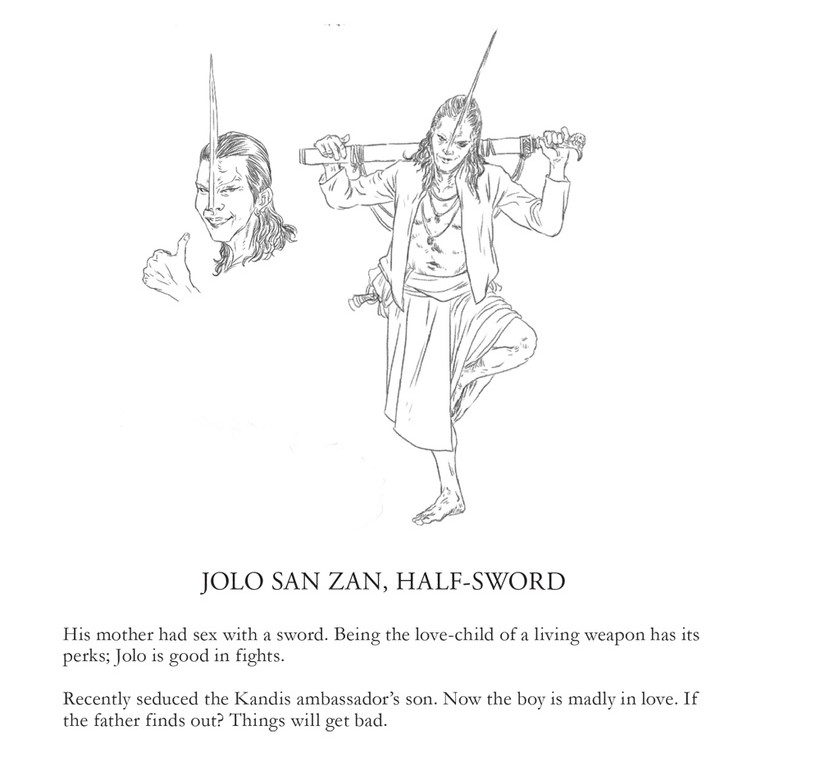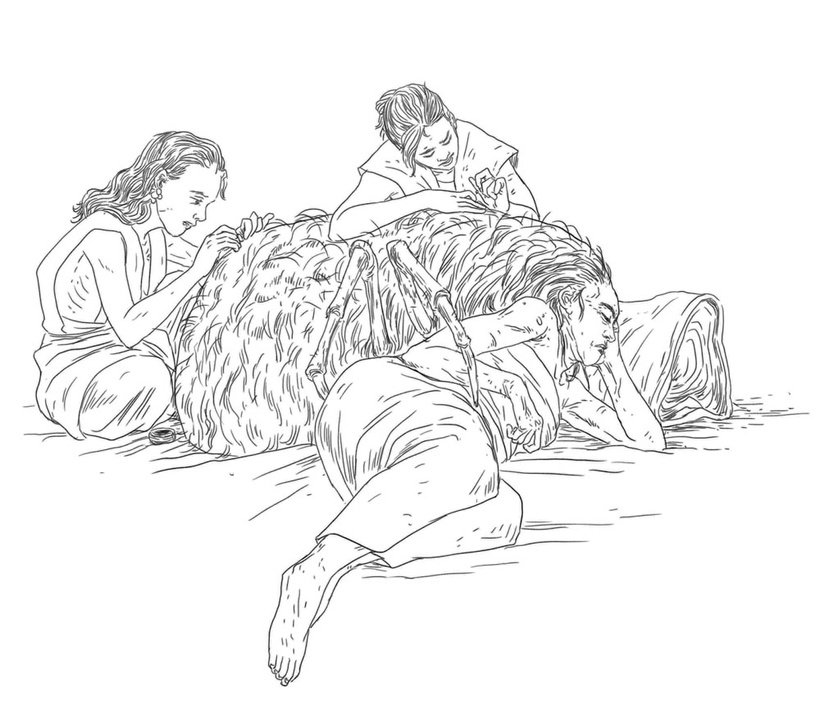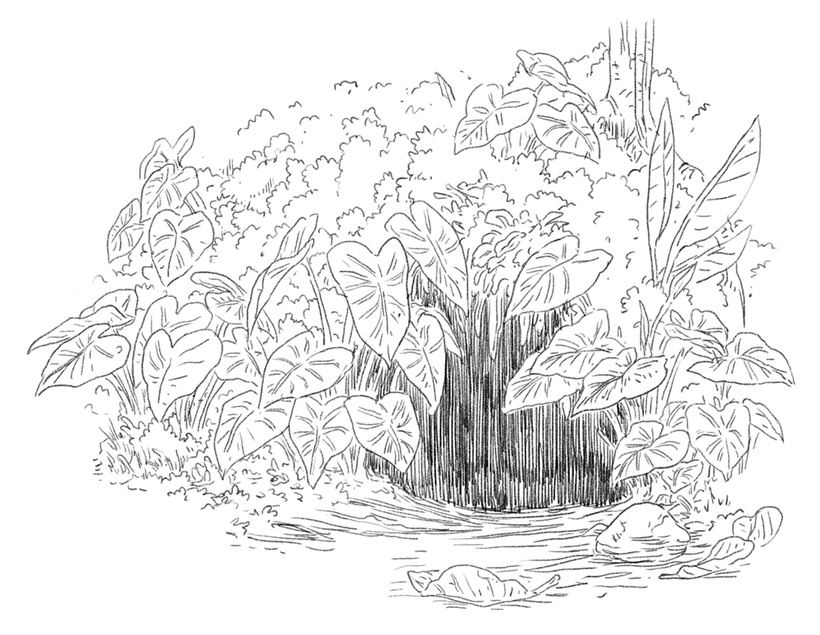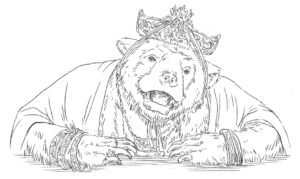
Working on Reach Of The Roach God has actually been quite challenging for me. Having drawn A Thousand Thousand Islands for over four years, I’ve developed certain approaches for the illustrations, but it does not really apply for ROTRG.
Previously, I tended towards a certain depiction of the mundane and boring in ATTI drawings, finding that it serves as an accessible conduit and point of entry for more fantastical ideas.
Like the image above; from Korvu, a boatwright, a shaman maker of magical boat prows for Korvu knights to replace their living heads. It’s a fantastical idea but the depiction is pretty boring, with the assistant channeling the vibe I wanted.
But before I get to the drawings that were difficult for my mundane approach, I thought it necessary to write a bit about the mundanity itself. While the choice has been largely instinctive, without strict rules, here are some things I find myself inclined towards.
- An equal emphasis on trivial things and everyday items being used, not the big obvious giant magical sword.
- Usually coming from ideas that are logical extensions of real life, as opposed to a completely fantastical creation.
- Mundane, matter-of-fact poses, away from dramatic poses and angles.
Trivial objects
One of the main reasons this was a guiding light was the context of where ATTI exists. Unlike for Western fantasy, where there’s a long lineage as well as common knowledge of the history that it takes inspiration from, there’s much less fantasy/pop cultural products in Southeast Asia. Historical knowledge is also not as common. And if either exists, chances are it’s been heavily coloured by ethno-nationalistic sentiments.
For me, what comes out of that is an unfamiliarity to history and imagination.
Interestingly, to help with imagination, I find illustrating ATTI with as many trivial objects and everyday items helps to counter this lack of imagination and unfamiliarity. The rattan walls, bamboo cups, thatched roofs, etc. help familiarize and reinforce this world.
I needed the visual vocabulary to feel more comfortable to imagine, rather than focusing on just the obvious giant magical sword. And for audiences, hopefully it also hints at the world and helps the immersion.
The intent is both to familiarize and to centre the fantasy world within a Southeast Asia setting.

This is from Kraching, a mysterious town with too many cats. The headwear of the villagers are folded to look like cat ears, while a common tool is a sickle, because they look like cat claws.
Logical Extension of Matter-Of-Fact
Something often mentioned by Zedeck and I is the everyday fantastical nature of Southeast Asia: the spirits, the land, the ghosts, etc.
The supernatural and fantastical is in the background of life in Southeast Asia and just another aspect of living. The house is haunted but you’ve still got to do your laundry etc. Going to the hypermarket with the grocery list on your smartphone, offerings for Deities are listed right above dishwashing liquid.
On some level, it’s wild, but on another, it’s so mundane and matter-of-fact.
Many inspirations and ideas come from this place, and the illustrations follow up with that mundaneness.

This is Jolo San Zan from Mr-Kr-Gr, one of my favourite characters we’ve made. He’s born from the coupling of a sword and a human. It’s silly and absurd but it plays with ideas of sentient magical weapons.
Not uncommon in Southeast Asia, these weapons are high maintenance, there are rituals to do, you have to bathe it and feed it. They’ve got personalities and are pretty “human”.
Take this to its logical conclusion and you might get a sword falling in love, mating, having children.
Not strange in this world, no big deal, matter-of-fact.
Boring Poses
Frankly, I’m still figuring out why most ATTI poses tend toward the boring. Sometimes I pick out drawings that I find too dynamic and redraw a duller version.
I suspect the impulse to do so comes from a combination of the two points mentioned above.
Non-dynamic visualizations suggest that however absurd the fantasy is, it’s a part of that world, nothing to be moved by. It’s absurd but unremarkable.
I find that poses that are less glamorous also help situate a character and place it in this world we are building, how it exists in this world.
An entrance to the cave.

From Andjang, a tick demon queen has a huge head full of blood. Here she is, needing to get her head picked off from lice and possibly actual ticks too?
In the whole zine, there’s only one image of the tick demon that is dynamic and action-y.
(I also suspect boring poses only apply to our setting zines where the focus is on the world itself. This might change if I were to illustrate characters for a different purpose.)
Boring Into A Cave
I’ve become relatively comfortable with these methods until Reach Of The Roach God came along because:
A large part of ROTRG is set deep inside a cave.
But there are no deep cave civilizations in Southeast Asia, or anywhere in the world, right? There are no logical extensions of real life ideas to draw from. Where do I draw my references from? What do objects look like in a Southeast Asian cave setting?

In the next post, I’ll share some of the struggles and solutions to circumvent them.
This post was originally published July 27, 2021 on the A Thousand Thousand Islands Patreon.

